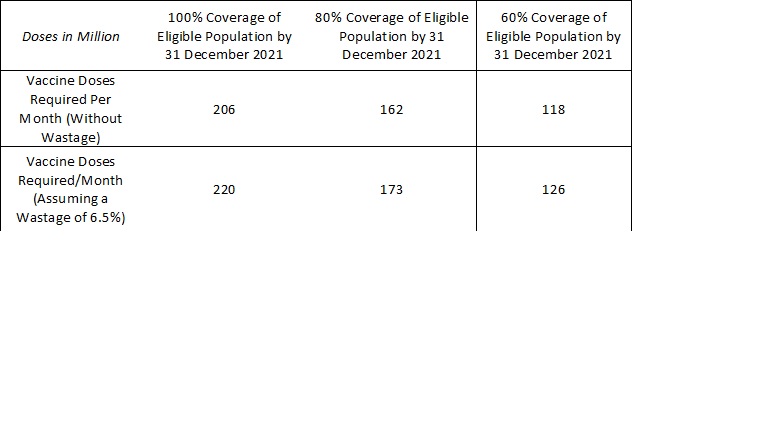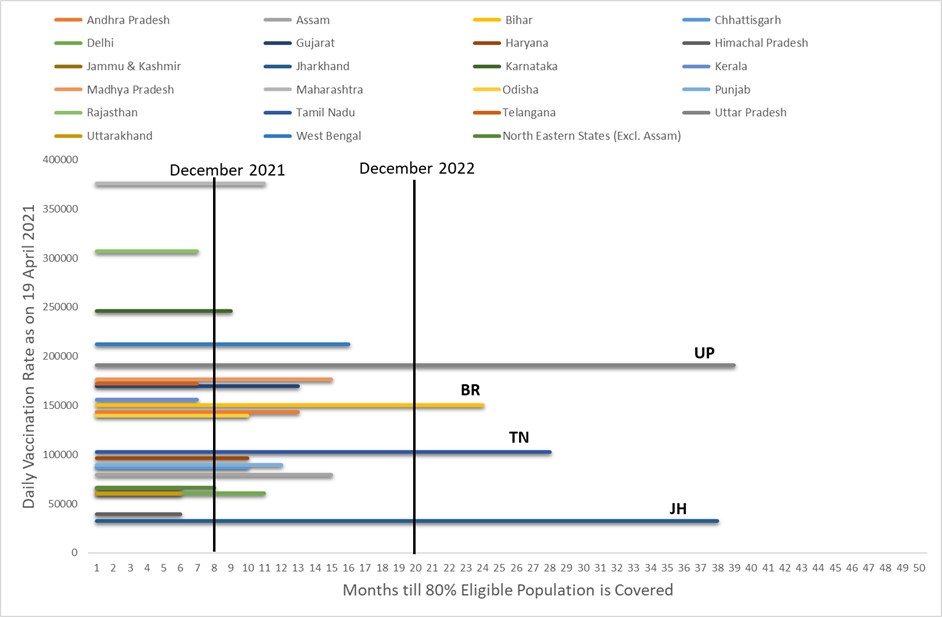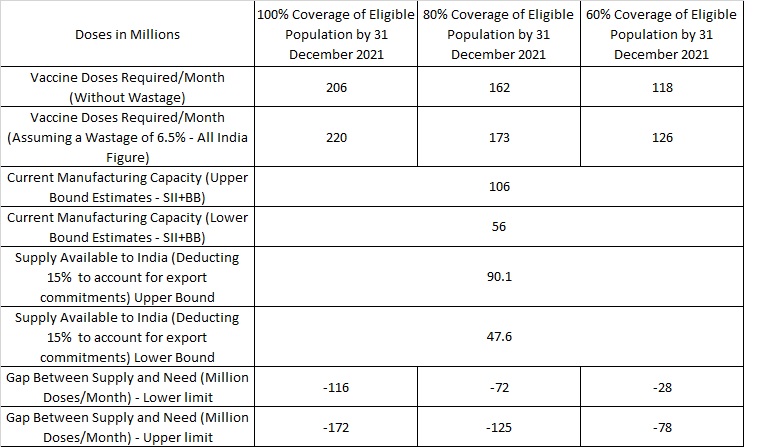
Thread On the Supply-Need Vaccination Gap: At the current rate of vaccination, this will happen only by November 2022. If India wishes to cover 60 to 100% of its eligible population by December 2021, the current gap between need and supply is about 70 to 170 million doses/month
1/n: 69% of India’s population is above 18 years of age in 2021, i.e. technically eligible for the COVID-19 Gap (as per estimates of the MoHFW). This varies between 60% in Bihar to 76% in Tamil Nadu.
2/n: To cover 100% of the eligible population India will need a total of 1878 million doses of the vaccine, assuming each person requires two doses. To cover 80% and 60% of the eligible population, this requirement reduces to 1502 million doses and 1127 million doses respectively
3/n: As of 19 April 2021, at an all-India level, 124 million doses had been administered – 91% of these are of COVISHIELD, produced by the Serum Institute of India, and 9% of COVAXIN developed and manufactured by Bharat Biotech.
4/n About 1002 to 1753 million additional doses are therefore still needed to cover 60 to 100% of the eligible population. Summarized in the Table 

5/n: 12% of eligible population in India had got at least one dose till 19 April, but varies across states- Chhattisgarh has given at least one dose to 23% of its eligible population. Himachal Pradesh - 21%, Kerala 20% But UP and Assam have covered only 6% with at least 1 dose.
6/n: At the current rate of vaccination, 100% of the eligible population will only be covered by October 2022. It will be June 2022 till we cover 80% and February 2022 till we cover 60% of the eligible population. This also varies by state. Shown in Chart 

7/n: Four States - UP, Bihar, Jharkhand, and TN are unlikely to cover this target even till the end of next year. To vaccinate 80 to 100% of eligible population by December 2021, rate of dose administration at all-India level must increase by 66 to 112% percent
8/n: This also varies by states. For Bihar, where election promises included free COVID-19 vaccines for all, an increase of 115 to 270% in the current rate of vaccine administration is required to cover 60-100% of the eligible population by December 2021
9/n: On the supply side - SII has a manufacturing capacity of about 70 to 100 million doses/month. (includes existing and planned capacity). Bharat Biotech has a manufacturing capacity of 6 million doses per month which is to increase to 15 million doses per month by May 2021.
10/n: Account for 15% export commitments and about 6.5% wastage of doses at the all-India level, gap between supply available and need for vaccination is given in Table 

11/n: As per published interviews SII is already turning a profit at a price of Rs.150/dose. At this price the cost of covering 100% of eligible population would be about Rs.26000 crore, less than amount allocated specifically for vaccination in the Union Budget for 2021-22.
12/n: At a price of Rs.400/dose, this price increases to Rs. 70,000 crore. Rationale for price increase is not clear. SII has essentially emerged as a monopoly player in the market. 91% of the doses administered in India till 19 April 2021 are of COVISHIELD
13/n: Manufacturing capacity of SII far outstrips that of only other player in the market, i.e. Bharat Biotech. If it really wanted to go the market route, the Government could have bolstered the production of COVAXIN to create at least a semblance of competition
14/n: But we now have a producer declared price which is not a “discovered” competitive price, but a monopoly price ensuring windfall profits to the producer, at a cost to the state, the citizen, and if it depresses vaccine uptake then eventually to the economy.
15/n: What we need is large scale procurement by the Central Government at regulated prices, transparent allocation scheme to ensure equity across states, and decentralised local government driven strategies to ensure equitable access across economic classes.
Data Sources: 1. Population and Population distribution in 2021: main.mohfw.gov.in/sites/default/…
2.Vaccination Data: api.covid19india.org
3.Vaccine Manufacturing Capacity Data: thefederal.com/opinion/indias…
3.Vaccine Wastage: pib.gov.in/PressReleseDet…
2.Vaccination Data: api.covid19india.org
3.Vaccine Manufacturing Capacity Data: thefederal.com/opinion/indias…
3.Vaccine Wastage: pib.gov.in/PressReleseDet…
A few typos and mistakes. The first tweet in the thread says Nov2022 to cover 100% eligible population. It is October 2022. And the next tweet- 69% are eligible for the Covid vaccine not Covid gap.
• • •
Missing some Tweet in this thread? You can try to
force a refresh


